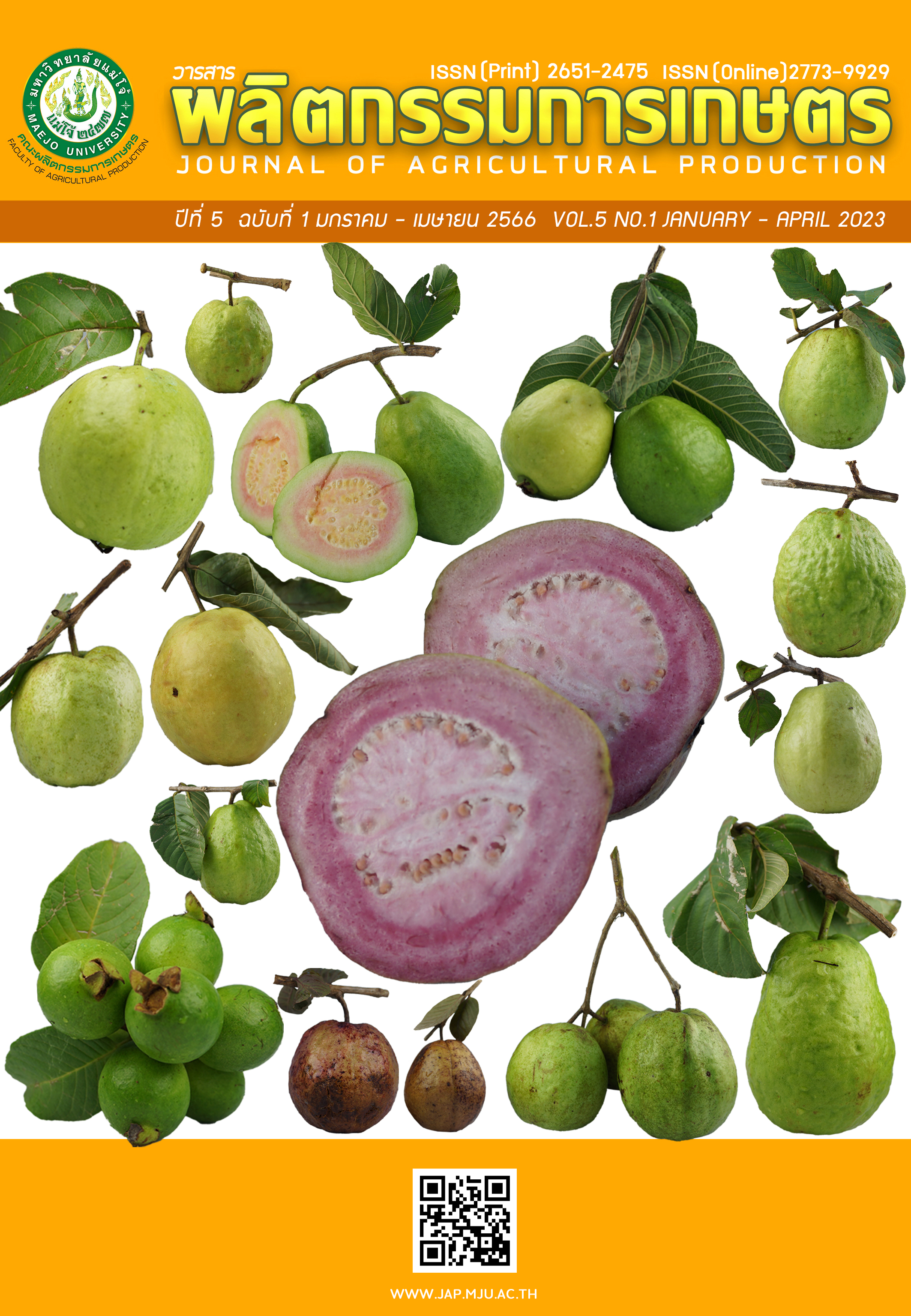ความสัมพันธ์ของสัตว์ขาปล้องขนาดเล็กในดินและคุณสมบัติดินระหว่างพื้นที่ป่าฟื้นฟูของศูนย์ศึกษาพัฒนาห้วยฮ่องไคร้ฯ อำเภอดอยสะเก็ด จังหวัดเชียงใหม่
Main Article Content
บทคัดย่อ
การศึกษาความสัมพันธ์ของสังคมสัตว์ขาปล้องขนาดเล็กในดินและคุณสมบัติดินในพื้นที่ป่าฟื้นฟูของศูนย์การศึกษาพัฒนาห้วยฮ่องไคร้ฯ อำเภอดอยสะเก็ด จังหวัดเชียงใหม่ โดยเก็บตัวอย่างดินตามลักษณะ การพัฒนาป่าไม้ 4 ประเภท ได้แก่ พื้นที่พัฒนาป่าไม้ด้วยนํ้าฝน พื้นที่พัฒนาป่าไม้ด้วยระบบชลประทาน พื้นที่พัฒนาป่าไม้ด้วยฝายต้นนํ้าลำธาร และพื้นที่พัฒนาป่าไม้ด้วยนํ้าฝนภายนอกศูนย์ฯ ทำการเก็บตัวอย่างดิน ด้วยพลั่วขนาด 15×15 เซนติเมตร ลึก 5 เซนติเมตร จำนวน 9 ซํ้าต่อพื้นที่ศึกษา เก็บสองตัวอย่าง ในวันที่ 8 มีนาคม 2561 (ช่วงฤดูแล้ง) และ 7 กันยายน 2561 (ช่วงฤดูฝน) ผลการศึกษาพบ จำนวนสัตว์ขาปล้อง ขนาดเล็กในดินทั้งหมด 8,113 ตัวอย่าง สามารถจำแนกออกเป็น 21 กลุ่มสัตว์ กลุ่มไรเป็นกลุ่มสัตว์ที่มี ความโดดเด่นที่สุดที่พบในทุกพื้นที่ศึกษา ซึ่งพบความหนาแน่นเฉลี่ยมากที่สุดถึง 2,496.3±3,921.3 ตัว ต่อตารางเมตร (41 เปอร์เซ็นต์) รองลงมาคือ กลุ่มเสี้ยนนมพบ 1,103.1±5,162.3 ตัวต่อตารางเมตร (16 เปอร์เซ็นต์) กลุ่มแมลงหางดีดพบ 388.9±553.2 ตัวต่อตารางเมตร (15 เปอร์เซ็นต์) และกลุ่มมด 377.8±493.6 ตัวต่อตารางเมตร (14 เปอร์เซ็นต์) ตามลำดับ ปริมาณความหนาแน่นของสัตว์ขาปล้อง ขนาดเล็กในดินในช่วงฤดูแล้ง (8,753±11,042 ตัวต่อตารางเมตร) สูงกว่าปริมาณความหนาแน่นในช่วง ฤดูฝน (1,113.6±740.1 ตัวต่อตารางเมตร) แตกต่างอย่างมีนัยสำคัญ (P<0.05) พื้นที่พัฒนาป่าไม้ด้วย ระบบชลประทานที่เป็นบริเวณที่มีนํ้าชลประทานไหลผ่านพื้นที่ตลอดปี ซึ่งมีสมบัติทางกายภาพ เคมี และ ชีวภาพบางประการของดินที่ดี พื้นที่นี้พบปริมาณความหนาแน่นของสัตว์ขาปล้องขนาดเล็กในดินมากที่สุด (1,1901±14,400 ตัวต่อตารางเมตร) รองลงมาคือ พื้นที่พัฒนาป่าไม้ด้วยนํ้าฝนภายนอกศูนย์ฯ (5,316±4,208.7 ตัวต่อตารางเมตร) พื้นที่พัฒนาป่าไม้ด้วยนํ้าฝน (1,614±1,360.1 ตัวต่อตารางเมตร) และพื้นที่พัฒนาป่าไม้ด้วยฝายต้นนํ้าลำธาร (901.2±643.2 ตัวต่อตารางเมตร) ตามลำดับ แม้ว่าพื้นที่พัฒนา ป่าไม้ด้วยฝายต้นนํ้าลำธาร มีสมบัติบางประการของดินค่อนข้างไม่ดี และพบปริมาณความหนาแน่น ของสัตว์ขาปล้องขนาดเล็กในดินน้อยที่สุดเช่นกัน แต่กลับมีค่าความหลากชนิดของแชนนอน-ไวเนอร์ และ ค่าดัชนีความสมํ่าเสมอสูงที่สุดเมื่อเปรียบเทียบกับพื้นที่ศึกษาอื่น
Article Details

อนุญาตภายใต้เงื่อนไข Creative Commons Attribution-NonCommercial-NoDerivatives 4.0 International License.
เอกสารอ้างอิง
เกษม คงนิรันดรสุข กาญจนา ชินสำราญ วุฒิ ทักษิณธรรม และสุรภพ สุทธิวิเศษ. 2557. ความหลากหลายของสัตว์ขาปล้องขนาดเล็กในดินที่สถานีวิจัยสิ่งแวดล้อมสะแกราช. Rajabhat Journal of Sciences, Humanities and Social Sciences 15(2): 45-53.
ณัฐดนัย ลิขิตตระการ และธนิษฐา ไชยชนะ. 2550. ประชากรตามฤดูกาลของสัตว์ขาปล้องขนาดเล็กในดินในสวนพฤกษศาสตร์สมเด็จพระนางเจ้าสิริกิติ์ จังหวัดเชียงใหม่. วารสารเกษตร 23(ฉบับพิเศษ): 397-402.
ณัฐนรี สาระพิมพ์ สุภัทรา ถึกสถิตย์ สมนิมิตร พุกงาม และยุทธพงษ์ คีรีมังคละ. 2559. สมบัติบางประการทางอุทกวิทยาของดินและสัตว์หน้าดิน ในพื้นที่การใช้ประโยชน์ที่ดินที่แตกต่างกัน บริเวณพื้นที่ลุ่มน้ำย่อยห้วยขมิ้น จังหวัดนครราชสีมา. วารสารวิจัย มข. (ฉบับบัณฑิตศึกษา) 16(2): 49-62.
ณัฐวุฒิ ธานี. 2557. ความหลากหลายของชนิดของแมลงในดินและความสัมพันธ์กับปัจจัยสิ่งแวดล้อมบางประการที่สถานีวิจัยสิ่งแวดล้อมสะแกราชจังหวัดนครราชสีมา. รายงานผลการวิจัย. สำนักวิชาวิทยาศาสตร์: มหาวิทยาลัยเทคโนโลยีสุรนารี.
ธินี เสวตร ดวงรัตน์ ธงภักดิ์ และชุลีมาศ บุญไทย อิวาย. 2556. ความสัมพันธ์ระหว่างความหลากหลายของสัตว์ไม่มีกระดูกสันหลังในดินกับพื้นที่ดินเค็ม. การประชุมทางวิชาการเสนอผลงานวิจัยระดับบัณฑิตศึกษา ครั้งที่ 14. น. 631-638.
นงลักษณ์ ปูระณะพงษ์. 2548. คู่มือการวิเคราะห์ดินและพืช. ภาควิชาทรัพยากรดินและสิ่งแวดล้อม คณะผลิตกรรมการเกษตร มหาวิทยาลัยแม่โจ้, เชียงใหม่.
ลำใย อิทธิจันทร์ ทัศนีย์ แจ่มจรรยา ยุพา หาญบุญทรง และวิทยา ตรีโลเกศ. 2551. ความหลากหลายของสัตว์ไม่มีกระดูกสันหลังในดินในสวนยางพารา. วารสารวิทยาศาสตร์เกษตร 39(3)(พิเศษ): 98-101.
สิรีมาตร จิตปาโล เดชา วิวัฒน์วิทยา และวิยะวัฒน์ ใจตรง. 2560. โครงสร้างทางสังคมของสัตว์ขาปล้องในดิน บริเวณอุทยานแห่งชาติดอยสุเทพ-ปุย จังหวัดเชียงใหม่. วารสารวนศาสตร์ 36(1): 11-21.
Amato, M., and J.N. Ladd. 1988. Assay for microbial biomass based on ninhydrin reactive nitrogen in extracts of fumigated soil. Soil Biology and Biochemistry 20: 107-114.
Brady, N.C. and R.R. Weil. 2008. The Nature and Properties of Soils. 14th ed. Prentice Hall, Inc., NJ.
Bray, R.H. and L.T. Kurtz. 1945. Determination of total, organic and available forms of phosphorus in soils. Soil Science 59: 39-45.
Dindal, D.L. 1990. Soil Biology Guide. A Wiley-Interscience Publication, John Wiley & Sons. 1,376 p.
Duyar, A. and E. Makineci. 2016. Seasonal and altitudinal variations of soil arthropods in Abies nordmanniana subsp. bornmulleriana forests. Bosque 37(2): 335-345.
John, A.W. 1970. Ecology of Soil Animals. England: McGraw-Hill Publishing Company Limited. 280 p.
Khamyong, S., P. Sutthaw and S. Paramee. 2016. Dry Dipterocarp Forest on Sandstone of the Huai Hong Khrai Royal Development Study Center, Chiang Mai Province I. Assessment of Plant Species Diversity and Carbon Storage. Thai Journal of Forestry 35(3): 42-55.
Marra, J.L. and R.L. Edmonds. 2005. Soil Arthropod Response to Differenct Patch Types in a Mixed-Conifer Forest of the Sierra Nevada. Forest Science 51(3): 255-265.
Mulder, C.P.H., E. Bazeley-White, P.G. Dimitrakopoulos, A. Hector, M. Sherer-Lorenzen and B. Schmid. 2004. Species evenness and productivity in experimental Plant communities. Oikos 107: 50-63.
N’Dri, J.K., F.A. Seka, P.K. Pokou and R.A.G. N’Da. 2017. Abundance and diversity of soil mite (Acari) communities after conversion of tropical secondary forest into rubber plantations in Grand-Lahou, Côte d’Ivoire. Ecological Research 32: 909-919.
Naumann, I.D., P.B. Came, J.F. Lawrence, E.S. Nielsen, J.P. Spradbery, R.W. Taylor, M.J. Whitten and M.J. Littlejohn. 1991. The Insects of Australia: A Textbook for Students and Research Workers, 2nd edition. Division of Entomology, CSIRO, Australia. Melbourne University Press, Melbourne, Australia, and Cornell University Press, Ithaca, New York.
Parisi, V., C. Menta, C. Gardi, C. Jacomini and E. Mozzanica, 2005. Microarthropod communities as a tool to assess soil quality and biodiversity: a new approach in Italy. Agriculture Ecosystems and Environment 105: 323-333.
Potapova, N.A., 1999. Postfire demutations of population of soil invertebrates. pp. 519-529. In: Smirnova, O.V. and E.S. Shaposhnikov (eds.). Succession Processes in Nature Resereves of Russia and Problems of Conservation of Biological Diversity. Russian Botanical Society, St. Petersburg. [in Russian]
Shannon, C.E. 1948. A mathematical theory of communication. Bell System Technical Journal 27: 379-423, 623-656.
Staff of soil science. 1998. Basic of soil science. 8th edition. Kasetsart University Press, Bangkok.
Sutthawan, P., S. Khamyong, S. Paramee and N. Anongrak. 2016. Dry Dipterocarp Forest on Sandstone of the Huai Hong Khrai Royal Development Study Center, Chiang Mai Province II. Monitoring Plant Diversity and Carbon Storage. Thai Journal of Forestry 35(3): 56-71.
Sutthawan, P., S. Khamyong, S. Paramee and N. Anongrak. 2016. Dry dipterocarp forest on sandstone of the Huai Hong Khrai royal development study center, Chiang Mai Province II. Monitoring plant diversity and carbon storage. Thai Journal of Forestry 35(3): 56-71.
Sylvia, D.M, J.J. Fuhrmann, P.G. Hartel and D.A. Zuberer. 2005. Principles and Applications of Soil Microbiology 2nd Edition. New Jersey: Pearson Education Inc.
Thippayarugs, S., B. Toomsan, P. Vityakon, V. Limpinuntana, A. Patanothai and G.G. Cadisch. 2008. Interactions in decomposition and N mineralization between tropical legume residue components. Agroforestry Systems 72: 137-148.
Triplehorn, C.A. and N.F. Johnson, 2005. Borror and Delong’s Introduction to the Study of Insects. 7th Edition. USA: Rinehart and Winston Inc.
Vityakon, P., S. MeepechGeorg, C. Cadisch and B. Toomsan. 2000. Soil organic matter and nitrogen transformation mediated by plant residues of different qualities in sandy upland and paddy soils. NJAS: wageningen journal of life sciences 48(1): 75-90
Volobuev, V.R. 1964. Ecology of soils. Isreal Program for Scientific Translations, Ltd.
Wanthongchai, K., J. Bauhus and J.G. Goldammer. 2014. Effects of past burning frequency on woody plant structure and composition in dry dipterocarp forest. Thai Journal of Forestry 33(3), 109-130.
Webster, E.A., D.W. Hopkin, J.A. Chudek, S.F.I. Haslam, M. Simek and T. Picek. 2001. The relationship between microbial carbon and resource quality of soil carbon. Journal of Environmental quality 30: 147-150.
Zhang, G., Zeng, G.M., Jiang, Y.M., Du, C.Y., Huang, G.H., Yao, J.M., Zeng, M., Zhang, X.L. & Tan, W. 2006. Seasonal dry deposition and canopy leaching of base cations in a subtropical evergreen mixed forest, China. Silva Fennica 40(3): 417-428 .


